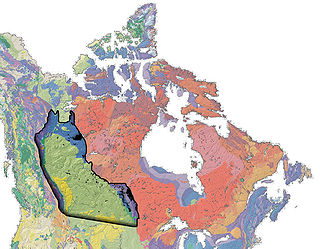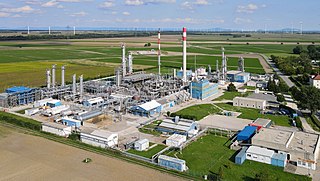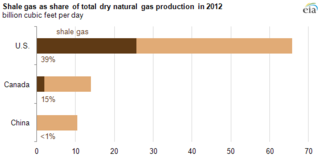Related Research Articles

Bituminous coal, or black coal, is a type of coal containing a tar-like substance called bitumen or asphalt. Its coloration can be black or sometimes dark brown; often there are well-defined bands of bright and dull material within the seams. It is typically hard but friable. Its quality is ranked higher than lignite and sub-bituminous coal, but lesser than anthracite. It is the most abundant rank of coal, with deposits found around the world, often in rocks of Carboniferous age. Bituminous coal is formed from sub-bituminous coal that is buried deeply enough to be heated to 85 °C (185 °F) or higher.

Adsorption is the adhesion of atoms, ions or molecules from a gas, liquid or dissolved solid to a surface. This process creates a film of the adsorbate on the surface of the adsorbent. This process differs from absorption, in which a fluid is dissolved by or permeates a liquid or solid. While adsorption does often precede absorption, which involves the transfer of the absorbate into the volume of the absorbent material, alternatively, adsorption is distinctly a surface phenomenon, wherein the adsorbate does not penetrate through the material surface and into the bulk of the adsorbent. The term sorption encompasses both adsorption and absorption, and desorption is the reverse of sorption.

Solid fuel refers to various forms of solid material that can be burnt to release energy, providing heat and light through the process of combustion. Solid fuels can be contrasted with liquid fuels and gaseous fuels. Common examples of solid fuels include wood, charcoal, peat, coal, hexamine fuel tablets, dry dung, wood pellets, corn, wheat, rice, rye, and other grains. Solid fuels are extensively used in rocketry as solid propellants. Solid fuels have been used throughout human history to create fire and solid fuel is still in widespread use throughout the world in the present day.

Coalbed methane, coalbed gas, or coal seam gas (CSG) is a form of natural gas extracted from coal beds. In recent decades it has become an important source of energy in United States, Canada, Australia, and other countries.

Shahdol District is a district of Madhya Pradesh state in east central India. It old name was Matsya raj or Virat kingdom in the name of great king Maharaja Virata. With a total area of 6,205 km2 (2,396 sq mi) and a population of 10,66,063. Shahdol is an important district of Madhya Pradesh. The town of Shahdol is the district headquarters. The district formerly comprised Shahdol division.
Coal analysis techniques are specific analytical methods designed to measure the particular physical and chemical properties of coals. These methods are used primarily to determine the suitability of coal for coking, power generation or for iron ore smelting in the manufacture of steel.
Underground coal gasification (UCG) is an industrial process which converts coal into product gas. UCG is an in-situ gasification process, carried out in non-mined coal seams using injection of oxidants and steam. The product gas is brought to the surface through production wells drilled from the surface.

At equilibrium, the relationship between water content and equilibrium relative humidity of a material can be displayed graphically by a curve, the so-called moisture sorption isotherm. For each humidity value, a sorption isotherm indicates the corresponding water content value at a given, constant temperature. If the composition or quality of the material changes, then its sorption behaviour also changes. Because of the complexity of sorption process the isotherms cannot be determined explicitly by calculation, but must be recorded experimentally for each product.

The Western Canadian Sedimentary Basin (WCSB) underlies 1.4 million square kilometres (540,000 sq mi) of Western Canada including southwestern Manitoba, southern Saskatchewan, Alberta, northeastern British Columbia and the southwest corner of the Northwest Territories. This vast sedimentary basin consists of a massive wedge of sedimentary rock extending from the Rocky Mountains in the west to the Canadian Shield in the east. This wedge is about 6 kilometres (3.7 mi) thick under the Rocky Mountains, but thins to zero at its eastern margins. The WCSB contains one of the world's largest reserves of petroleum and natural gas and supplies much of the North American market, producing more than 450 million cubic metres per day of gas in 2000. It also has huge reserves of coal. Of the provinces and territories within the WCSB, Alberta has most of the oil and gas reserves and almost all of the oil sands.

Natural-gas processing is a range of industrial processes designed to purify raw natural gas by removing contaminants such as solids, water, carbon dioxide (CO2), hydrogen sulfide (H2S), mercury and higher molecular mass hydrocarbons (condensate) to produce pipeline quality dry natural gas for pipeline distribution and final use. Some of the substances which contaminate natural gas have economic value and are further processed or sold. Hydrocarbons that are liquid at ambient conditions: temperature and pressure (i.e., pentane and heavier) are called natural-gas condensate (sometimes also called natural gasoline or simply condensate).

Shale gas is an unconventional natural gas that is found trapped within shale formations. Since the 1990s a combination of horizontal drilling and hydraulic fracturing has made large volumes of shale gas more economical to produce, and some analysts expect that shale gas will greatly expand worldwide energy supply.

The Cahaba Basin is a geologic area of central Alabama developed for coal and coalbed methane (CBM) production. Centered in eastern Bibb and southwestern Shelby Counties, the basin is significantly smaller in area and production than the larger Black Warrior Basin in Tuscaloosa and western Jefferson Counties to the northwest. The coalbed methane is produced from the Gurnee Field of the Pottsville Coal Interval. Coalbed gas production has been continuous since at least 1990 and annual gas production has increased from 344,875 Mcf in 1990 to 3,154, 554 Mcf through October 2007.
Enhanced coal bed methane recovery is a method of producing additional coalbed methane from a source rock, similar to enhanced oil recovery applied to oil fields. Carbon dioxide (CO2) injected into a bituminous coal bed would occupy pore space and also adsorb onto the carbon in the coal at approximately twice the rate of methane (CH4), allowing for potential enhanced gas recovery. This technique may be used in conjunction with carbon capture and storage in mitigation of global warming where the carbon dioxide that is sequestered is captured from the output of fossil fuel power plants.
Supercritical adsorption also referred to as the adsorption of supercritical fluids, is the adsorption at above-critical temperatures. There are different tacit understandings of supercritical fluids. For example, “a fluid is considered to be ‘supercritical’ when its temperature and pressure exceed the temperature and pressure at the critical point”. In the studies of supercritical extraction, however, “supercritical fluid” is applied for a narrow temperature region of 1-1.2 or to +10 K, which is called the supercritical region.
QGC Pty Ltd is one of the largest of several Australian coalbed methane companies developing methane reserves within the Bowen and Surat Basins of Queensland. The company has an estimated value of around A$13 billion.
Sohagpur Coalfield is located in Shahdol district in the Indian state of Madhya Pradesh in the basin of the Son River. It is the biggest coalfield in the state of Madhya Pradesh.
The Zonguldak basin of northwestern Turkey is the only basin in Turkey with mineable coal deposits. It has been mined for coal since the late 1800s. The basin takes its name after Zonguldak, Turkey, and lies at approximately 41° N. It is roughly elliptical in shape with its long axis oriented roughly southwest to northeast, and is adjacent to the Black Sea. Three main regions have been recognized in the Zonguldak basin: from west to east, Armutcuk, Zonguldak, and Amasra.

The 2017 production of coalbed methane in the United States was 0.98 trillion cubic feet (TCF), 3.6 percent of all US dry gas production that year. The 2017 production was down from the peak of 1.97 TCF in 2008. Most coalbed methane production came from the Rocky Mountain states of Colorado, Wyoming, and New Mexico.
Great Eastern Energy Corporation Limited is a Coalbed methane production company, which is located in Asansol district of West Bengal. With two CBM blocks, one in Raniganj at West Bengal and the other one in Mannargudi at Tamil Nadu, it has played an important role in providing methane gas. The wells dug in the respective blocks are well connected with Gas Gathering Stations and gas is fed into its dedicated steel pipeline network to maintain the supply.

Unconventional reservoirs, or unconventional resources are accumulations where oil and gas phases are tightly bound to the rock fabric by strong capillary forces, requiring specialised measures for evaluation and extraction.
References
- ↑ Lennon, Linda (19 August 2020). "Coalbed Methane". All Things Cretaceous. Science Education Resource Center, Carleton College, Minnesota, USA. Archived from the original on 22 November 2018. Retrieved 21 August 2020.
- ↑ NatureScot (2020-08-25). "Career through a lens: my favourite photographic memories". Scotland's Nature. Retrieved 2023-11-04.
- ↑ Coalbed methane Archived 2006-09-18 at the Wayback Machine
- ↑ "Investigation of Enhanced Coal Bed Methane (ECBM) Processes - Gravimetric Adsorption Measurements under Realistic Conditions". Archived from the original on 2014-04-23. Retrieved 2013-07-24.